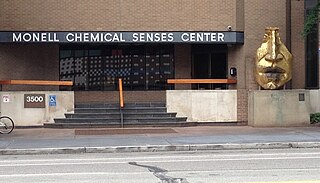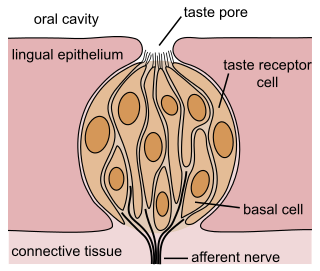
Olfactory receptors (ORs), also known as odorant receptors, are chemoreceptors expressed in the cell membranes of olfactory receptor neurons and are responsible for the detection of odorants which give rise to the sense of smell. Activated olfactory receptors trigger nerve impulses which transmit information about odor to the brain. In vertebrates, these receptors are members of the class A rhodopsin-like family of G protein-coupled receptors (GPCRs). The olfactory receptors form a multigene family consisting of around 400 genes in humans and 1400 genes in mice. In insects, olfactory receptors are members of an unrelated group of ligand-gated ion channels.

Sweetness is a basic taste most commonly perceived when eating foods rich in sugars. Sweet tastes are generally regarded as pleasurable. In addition to sugars like sucrose, many other chemical compounds are sweet, including aldehydes, ketones, and sugar alcohols. Some are sweet at very low concentrations, allowing their use as non-caloric sugar substitutes. Such non-sugar sweeteners include saccharin, aspartame, sucralose and stevia. Other compounds, such as miraculin, may alter perception of sweetness itself.
Aftertaste is the taste intensity of a food or beverage that is perceived immediately after that food or beverage is removed from the mouth. The aftertastes of different foods and beverages can vary by intensity and over time, but the unifying feature of aftertaste is that it is perceived after a food or beverage is either swallowed or spat out. The neurobiological mechanisms of taste signal transduction from the taste receptors in the mouth to the brain have not yet been fully understood. However, the primary taste processing area located in the insula has been observed to be involved in aftertaste perception.
Charles S. Zuker is a Chilean molecular geneticist and neurobiologist. Zuker is a Professor of Biochemistry & Molecular Biophysics and a Professor of Neuroscience at Columbia University. He has been an Investigator of the Howard Hughes Medical Institute since 1989.

TAS2R16 is a bitter taste receptor and one of the 25 TAS2Rs. TAS2Rs are receptors that belong to the G-protein-coupled receptors (GPCRs) family. These receptors detect various bitter substances found in nature as agonists, and get stimulated. TAS2R16 receptor is mainly expressed within taste buds present on the surface of the tongue and palate epithelium. TAS2R16 is activated by bitter β-glucopyranosides
Trace amine-associated receptors (TAARs), sometimes referred to as trace amine receptors, are a class of G protein-coupled receptors that were discovered in 2001. TAAR1, the first of six functional human TAARs, has gained considerable interest in academic and proprietary pharmaceutical research due to its role as the endogenous receptor for the trace amines phenethylamine, tyramine, and tryptamine – metabolic derivatives of the amino acids phenylalanine, tyrosine and tryptophan, respectively – ephedrine, as well as the synthetic psychostimulants, amphetamine, methamphetamine and methylenedioxymethamphetamine. In 2004, it was shown that mammalian TAAR1 is also a receptor for thyronamines, decarboxylated and deiodinated relatives of thyroid hormones. TAAR2–TAAR9 function as olfactory receptors for volatile amine odorants in vertebrates.

The Monell Chemical Senses Center is an independent, non-profit scientific research institute located at the University City Science Center campus in Philadelphia. Founded in 1968, it is dedicated to interdisciplinary basic research on the senses of taste and smell. The center's mission is to improve health and well-being by advancing the scientific understanding of taste, smell, and related senses. Monell's research focuses on various aspects of chemosensory science, including how chemical senses affect human health, behavior, and the environment. The center employs a collaborative and interdisciplinary approach, with scientists from diverse fields such as sensory psychology, biophysics, chemistry, behavioral neuroscience, environmental science, and genetics working together on research projects.

Growth hormone receptor is a protein that in humans is encoded by the GHR gene. GHR orthologs have been identified in most mammals.

A taste receptor or tastant is a type of cellular receptor that facilitates the sensation of taste. When food or other substances enter the mouth, molecules interact with saliva and are bound to taste receptors in the oral cavity and other locations. Molecules which give a sensation of taste are considered "sapid".

Taste receptor 2 member 38 is a protein that in humans is encoded by the TAS2R38 gene. TAS2R38 is a bitter taste receptor; varying genotypes of TAS2R38 influence the ability to taste both 6-n-propylthiouracil (PROP) and phenylthiocarbamide (PTC). Though it has often been proposed that varying taste receptor genotypes could influence tasting ability, TAS2R38 is one of the few taste receptors shown to have this function.
Danielle Renee Reed is an American geneticist employed at the Monell Chemical Senses Center in Philadelphia, Pennsylvania. She is most notable for her papers regarding genetic variation in taste and obesity in mice and humans.

Taste receptor type 2 member 4 is a protein that in humans is encoded by the TAS2R4 gene.

Taste receptor type 2 member 14 is a protein that in humans is encoded by the TAS2R14 gene.

T1R2 - Taste receptor type 1 member 2 is a protein that in humans is encoded by the TAS1R2 gene.

Taste receptors for bitter substances (T2Rs/TAS2Rs) belong to the family of G-protein coupled receptors and are related to class A-like GPCRs. There are 25 known T2Rs in humans responsible for bitter taste perception.

Taste receptor type 2 member 19 is a protein that in humans is encoded by the TAS2R19 gene. It seems to be involved in the perception of salt and bitter tastes.

Taste receptor type 2 member 50 is a protein that in humans is encoded by the TAS2R50 gene.

The gustatory system or sense of taste is the sensory system that is partially responsible for the perception of taste (flavor). Taste is the perception stimulated when a substance in the mouth reacts chemically with taste receptor cells located on taste buds in the oral cavity, mostly on the tongue. Taste, along with the sense of smell and trigeminal nerve stimulation, determines flavors of food and other substances. Humans have taste receptors on taste buds and other areas, including the upper surface of the tongue and the epiglottis. The gustatory cortex is responsible for the perception of taste.
A sense is a biological system used by an organism for sensation, the process of gathering information about the surroundings through the detection of stimuli. Although, in some cultures, five human senses were traditionally identified as such, many more are now recognized. Senses used by non-human organisms are even greater in variety and number. During sensation, sense organs collect various stimuli for transduction, meaning transformation into a form that can be understood by the brain. Sensation and perception are fundamental to nearly every aspect of an organism's cognition, behavior and thought.

Mary J. O'Connell is an evolutionary genomicist and Associate Professor at the University of Nottingham. She is the Principal Investigator of the Computational & Molecular Evolutionary Biology Group in the School of Life Sciences at the University of Nottingham.









